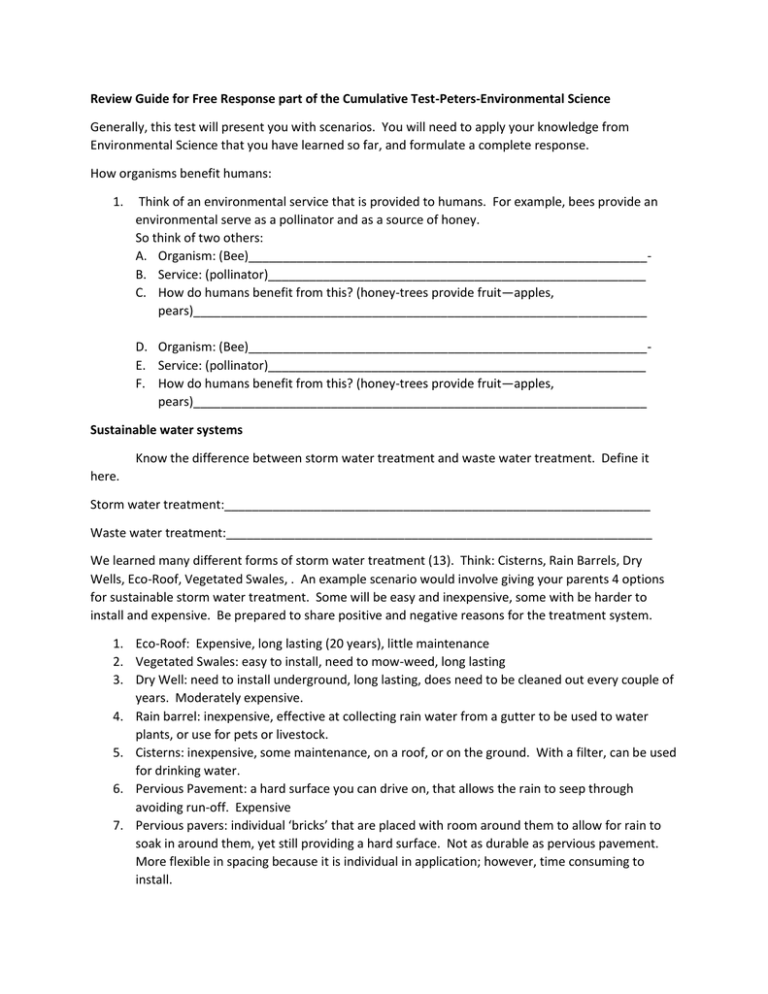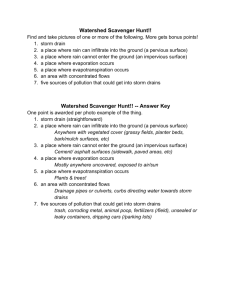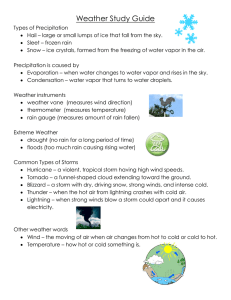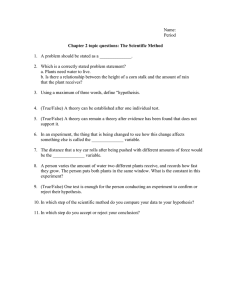Review Guide for Free Response part of the Cumulative Test-Peters-Environmental... Generally, this test will present you with scenarios. You... Environmental Science that you have learned so far, and formulate...
advertisement

Review Guide for Free Response part of the Cumulative Test-Peters-Environmental Science Generally, this test will present you with scenarios. You will need to apply your knowledge from Environmental Science that you have learned so far, and formulate a complete response. How organisms benefit humans: 1. Think of an environmental service that is provided to humans. For example, bees provide an environmental serve as a pollinator and as a source of honey. So think of two others: A. Organism: (Bee)__________________________________________________________B. Service: (pollinator)_______________________________________________________ C. How do humans benefit from this? (honey-trees provide fruit—apples, pears)__________________________________________________________________ D. Organism: (Bee)__________________________________________________________E. Service: (pollinator)_______________________________________________________ F. How do humans benefit from this? (honey-trees provide fruit—apples, pears)__________________________________________________________________ Sustainable water systems Know the difference between storm water treatment and waste water treatment. Define it here. Storm water treatment:______________________________________________________________ Waste water treatment:______________________________________________________________ We learned many different forms of storm water treatment (13). Think: Cisterns, Rain Barrels, Dry Wells, Eco-Roof, Vegetated Swales, . An example scenario would involve giving your parents 4 options for sustainable storm water treatment. Some will be easy and inexpensive, some with be harder to install and expensive. Be prepared to share positive and negative reasons for the treatment system. 1. Eco-Roof: Expensive, long lasting (20 years), little maintenance 2. Vegetated Swales: easy to install, need to mow-weed, long lasting 3. Dry Well: need to install underground, long lasting, does need to be cleaned out every couple of years. Moderately expensive. 4. Rain barrel: inexpensive, effective at collecting rain water from a gutter to be used to water plants, or use for pets or livestock. 5. Cisterns: inexpensive, some maintenance, on a roof, or on the ground. With a filter, can be used for drinking water. 6. Pervious Pavement: a hard surface you can drive on, that allows the rain to seep through avoiding run-off. Expensive 7. Pervious pavers: individual ‘bricks’ that are placed with room around them to allow for rain to soak in around them, yet still providing a hard surface. Not as durable as pervious pavement. More flexible in spacing because it is individual in application; however, time consuming to install. 8. Trees: a landscape element that provides many benefits, one of which is absorbing rainwater as it falls through the soil. It is beautiful, requires little maintenance, and lasts a long time. Pollutants effect our environment in a variety of ways. We studied several forms of pollutants. Think of some of them, and how they affect us. 1. Pollutant: CO2 a. Source: vehicles b. Damage: exhaust adds CO2 to our environment, adding to global warming creating smog 2. Pollutant: CFC’s a. Source: car air conditioners, aerosol cans (before banned) b. Damage: helped create the ozone (O3) ‘holes’ – be ready to describe the ‘holes’. 3. VOC’s (Volatile Organic Compounds) a. Source: Fuel containers, personal care products (nail polish remover), b. Damage: headaches, dizziness, light-headedness, drowsiness, nausea, and eye and respiratory irritation during exposure Think of several more to have available. Experiments and their parts: Hypothesis, Null Hypothesis, Experimental design, Dependent variable. Results that would support the null hypothesis. Results that would refute (not support) the null hypothesis. Study the parts (remember the straw tower lab at the beginning of the year?). Look in the beginning of your book. Here are some examples of experiments with the parts defined. (To be done) Plastics How do plastics impact our environment? They come from—fossil fuels, primarily oil. They do not disintegrate. They often end up in our oceans—damaging marine life. How are plastic bags used? You got this one. No help needed…. What about alternatives? How would you replace plastic bags in your life? Think of three ways. Define Tragedy of the Commons: Think about these parts. Who does this effect? How does it affect them? Why does it affect them? The example given in class involved sheep, and a town. Think about what can be considered ‘a commons’? Oceans, wilderness, city streets, buildings, cities, suburban areas….. How should these commons be managed?



